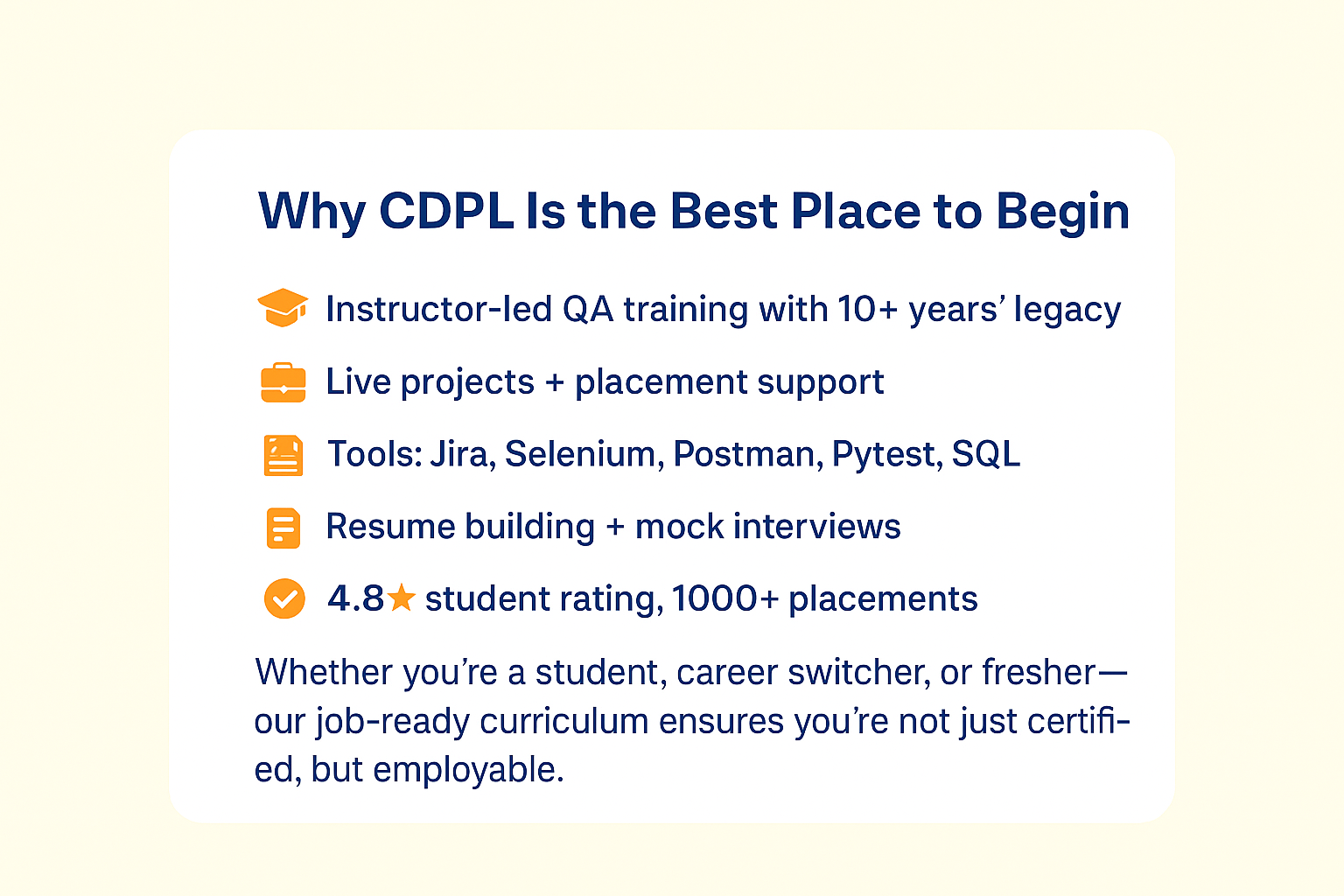
What Does a Software Tester Do?
A software tester is important in the software development process. They make sure that applications work well, have no bugs, and meet user needs. Testers act as the bridge between developers and end users, validating software functionality, performance, usability, and security across platforms.
In 2025, software testers are expected to work with manual testing tools, perform API checks, collaborate in Agile teams, and even write automated scripts using tools like Selenium or Postman. It's no longer just about clicking buttons—it's about understanding systems, simulating real user scenarios, and helping developers ship high-quality products.
Table of Contents
Why Become a Software Tester in 2025?
In today’s digital economy, every industry relies on software—banking, healthcare, e-commerce, education, travel, and logistics. As companies race to build better apps faster, the demand for quality assurance (QA) professionals is growing rapidly.
Here’s why becoming a software tester in 2025 is a smart move: - Entry-friendly: You don’t need a computer science degree to start. - High demand: Over 40,000+ openings for QA testers every month in India alone. - Good salary: Freshers earn ₹2.5–5 LPA. Automation testers earn ₹6–10 LPA. - Career growth: Move into roles like QA Lead, SDET, or Product Analyst.
Whether you’re a graduate, a working professional looking to switch, or even a 12th-pass student, software testing offers a job-ready path into IT.
Skills Required to Start a Career in QA
To start your journey as a software tester, you don’t need coding expertise. Instead, you’ll need to develop:
- Analytical thinking to understand user flows and identify bugs
- Attention to detail to find inconsistencies and UI glitches
- Basic logic and process understanding (e.g., if-else, cause-effect)
- Communication skills to report issues and write test cases
- Tool familiarity like Jira, Postman, or Selenium (you’ll learn this during training)
With the right mindset and willingness to learn, anyone can become a software tester in a few months.
Educational Eligibility to Become a Tester
One of the best parts about QA is that it doesn’t require a technical degree.
You can become a software tester if you are: - A graduate from any stream: B.Com, B.A., B.Sc., BBA, etc. - A 12th pass student who wants to upskill with IT training - A career switcher from BPO, sales, teaching, or support - A non-tech diploma holder with logical aptitude
You don't need to know programming. Manual testing courses help you get started without any coding prerequisites.
Step-by-Step Roadmap to Become a Software Tester
Here’s a complete step-by-step roadmap you can follow to become a software tester in 2025:
Step 1: Understand the Basics
Start by learning about the SDLC (Software Development Life Cycle) and STLC (Software Testing Life Cycle). This will give you the context of how software is developed and where QA fits in.
Step 2: Enrol in a QA Course (Manual + Automation)
Choose a structured course that covers: - Manual Testing Concepts - Test Plan/Test Case Writing - Bug Reporting Tools (Jira, Mantis) - Testing Techniques (Smoke, Regression, UI, UAT) - Basic Automation (Selenium + Java/Python) - API Testing using Postman - ISTQB Certification (optional, but powerful)
Step 3: Work on Real-Life Projects
Get your hands dirty with live project testing—whether it’s an e-commerce site or a banking app. Learn how to find bugs, report them, and communicate with developers.
Step 4: Build Your Resume & LinkedIn Profile
Highlight your tools, certifications, project experience, and skills clearly. CDPL helps with mock interviews, resume templates, and profile building.
Step 5: Apply for Jobs
Start applying for jobs as a: - QA Manual Tester - Junior Test Engineer - Software QA Analyst - Automation QA Intern (if you learned Selenium)
Tools You’ll Work With as a Beginner Tester
| Tool | Purpose |
|---|---|
| Jira | Bug tracking & Agile project mgmt |
| Mantis BT | Defect management |
| Postman | API request/response testing |
| Selenium | Automation testing with scripting |
| TestNG | Test suite management (Java) |
| MySQL | Backend validation & data checks |
These tools are taught during your training at Cinute Digital using real-world case studies.
Career Paths After QA Training
Once you enter the QA domain, here are some possible growth tracks:
- Manual QA → Automation Tester → QA Lead
- QA → API Tester → SDET
- QA Tester → Business Analyst → Product Owner
QA is no longer a dead-end career. It's dynamic, strategic, and deeply integrated with Agile, DevOps, and AI-based tools in modern software development.
Real-Life Story: From Arts Graduate to QA Analyst
Meet Mehul, an Arts graduate with no tech background. He joined Cinute Digital’s QA training program in 2024.
Starting with manual testing, he learned how to write test cases, use Jira, and run API tests with Postman. After 3 months, Mehul secured his first job as a QA Analyst at a mid-sized fintech startup with a ₹3.6 LPA package.
Today, he’s learning Selenium and preparing for his ISTQB certification—well on his way to becoming an Automation Engineer.
Want to start like Mehul? Check our upcoming batches
Why CDPL Is the Best Place to Begin

FAQs on Becoming a Software Tester
Q1. Can I become a tester without coding skills?
Yes. Start with manual testing, then gradually move into automation if you wish.
Q2. Do companies hire freshers for QA?
Yes. Many startups and MNCs hire trained freshers with practical skills.
Q3. How long does it take to become a tester?
You can become job-ready in just 2–3 months with focused training and project work.
Q4. Should I do ISTQB Certification?
It’s optional but adds strong credibility to your QA profile.
Q5. Is QA a long-term career?
Yes. QA roles now extend to Automation, DevOps, AI Testing, and Product Leadership.
Conclusion
Becoming a software tester in 2025 is one of the most strategic and accessible ways to enter the IT industry. With a clear learning path, powerful tools, and strong job demand, QA opens the door to both tech and career growth.
Whether you start with manual testing or jump into automation later, Cinute Digital is here to guide your journey with hands-on projects, expert mentorship, and a strong placement track record.
Ready to begin your QA career?